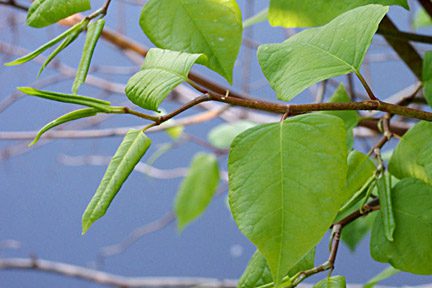It’s that time of year again when Japanese knotweed’s growing season draws to a close and the plant dies away, but specialists Environet are urging homeowners not to delay tackling the weed as it remains very much alive, waiting to emerge bigger and stronger with new shoots next March.
Although still standing, the bamboo-like canes will now be turning brown and brittle, which can fool homeowners into believing the plant has died or that their own efforts at treating it through cutting the plant back, or burning it, have been successful. However, like many plants, the rhizome system beneath the ground is healthy and lying dormant throughout the colder winter months.
Herbicide treatments cannot be used during winter as they require the plant to be in leaf, but that doesn’t mean treatment needs to be postponed until spring. In fact, Japanese knotweed can be dug out at any time of year using the environmentally friendly Resi-Dig-Out method, which involves digging out the rhizome roots and sifting out every viable piece before returning the clean soil to the ground. An insurance-backed guarantee can then be secured for the treatment which will ensure the property can be bought or sold without difficulty.
Nic Seal, MD and Founder of Environet comments: “Each winter we see enquiry levels fall, but we know Japanese knotweed hasn’t magically disappeared, it’s simply a case of out of sight, out of mind. Savvy homeowners will take action through the autumn and winter to tackle knotweed on their land, ensuring they don’t face an even bigger problem next spring. Digging knotweed out of the soil is an instant solution, giving homeowners complete peace of mind and the freedom to sell their property if they so wish.”
Homebuyers should be particularly vigilant when viewing properties during the winter months, when property owners may have taken advantage of the plant’s apparent demise in order to deliberately conceal it. Often the canes have been removed but the crown is still visible in the ground, or in extreme cases membranes are laid horizontally in the ground to conceal the knotweed, with a path or lawn laid over it.
A surveyor should be able to identify knotweed if it is visible, but deliberate concealment is illegal and sellers are required to answer truthfully to the direct question about Japanese knotweed on the TA6 Property Information form, completed during every property transaction. If a seller is dishonest or claims not to have known about the presence of knotweed, the buyer may have a claim for misrepresentation and are likely to be awarded the cost of professional treatment and legal fees, as well as any decrease in the property’s value.
A Guide to Identifying Japanese knotweed in Winter
As the temperature drops, the green heart shaped leaves will turn brown and fall from the plant.
In late November/early December the hollow, bamboo-like canes will turn brown and die, although they remain standing.
In March, red or purple asparagus type shoots will appear, quickly turning into green bamboo-like stems which grow at a rapid rate, reaching up to 3m in height.
Help keep news FREE for our readers
Supporting your local community newspaper/online news outlet is crucial now more than ever. If you believe in independent journalism, then consider making a valuable contribution by making a one-time or monthly donation. We operate in rural areas where providing unbiased news can be challenging. Read More About Supporting The West Wales Chronicle

























